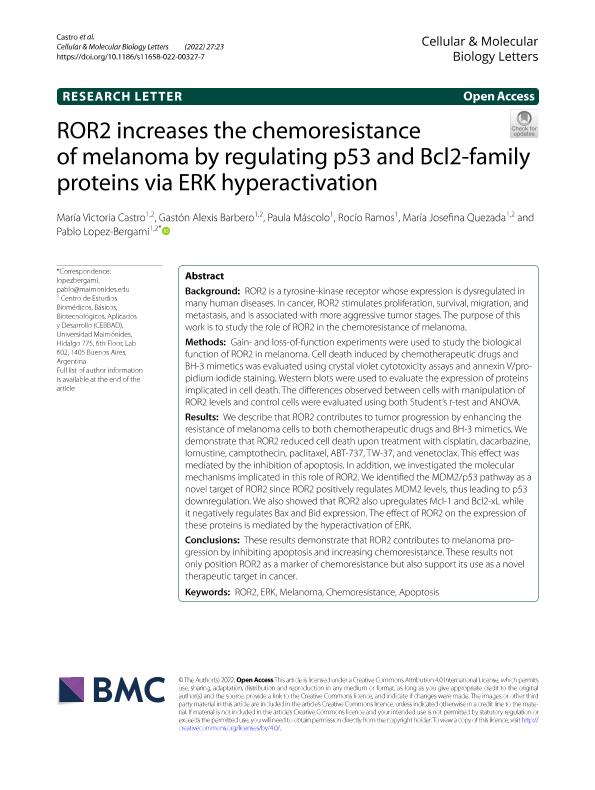Mostrar el registro sencillo del ítem
dc.contributor.author
Castro, María Victoria

dc.contributor.author
Barbero, Gastón Alexis

dc.contributor.author
Mascolo, Paula Denise

dc.contributor.author
Ramos, Rocío
dc.contributor.author
Quezada, Maria Josefina

dc.contributor.author
Lopez Bergami, Pablo Roberto

dc.date.available
2024-01-16T16:03:23Z
dc.date.issued
2022-03
dc.identifier.citation
Castro, María Victoria; Barbero, Gastón Alexis; Mascolo, Paula Denise; Ramos, Rocío; Quezada, Maria Josefina; et al.; ROR2 increases the chemoresistance of melanoma by regulating p53 and Bcl2-family proteins via ERK hyperactivation; BioMed Central; Cellular & Molecular Biology Letters; 27; 1; 3-2022; 1-13
dc.identifier.issn
1689-1392
dc.identifier.uri
http://hdl.handle.net/11336/223839
dc.description.abstract
Background: ROR2 is a tyrosine-kinase receptor whose expression is dysregulated in many human diseases. In cancer, ROR2 stimulates proliferation, survival, migration, and metastasis, and is associated with more aggressive tumor stages. The purpose of this work is to study the role of ROR2 in the chemoresistance of melanoma. Methods: Gain- and loss-of-function experiments were used to study the biological function of ROR2 in melanoma. Cell death induced by chemotherapeutic drugs and BH-3 mimetics was evaluated using crystal violet cytotoxicity assays and annexin V/propidium iodide staining. Western blots were used to evaluate the expression of proteins implicated in cell death. The differences observed between cells with manipulation of ROR2 levels and control cells were evaluated using both Student’s t-test and ANOVA. Results: We describe that ROR2 contributes to tumor progression by enhancing the resistance of melanoma cells to both chemotherapeutic drugs and BH-3 mimetics. We demonstrate that ROR2 reduced cell death upon treatment with cisplatin, dacarbazine, lomustine, camptothecin, paclitaxel, ABT-737, TW-37, and venetoclax. This effect was mediated by the inhibition of apoptosis. In addition, we investigated the molecular mechanisms implicated in this role of ROR2. We identified the MDM2/p53 pathway as a novel target of ROR2 since ROR2 positively regulates MDM2 levels, thus leading to p53 downregulation. We also showed that ROR2 also upregulates Mcl-1 and Bcl2-xL while it negatively regulates Bax and Bid expression. The effect of ROR2 on the expression of these proteins is mediated by the hyperactivation of ERK. Conclusions: These results demonstrate that ROR2 contributes to melanoma progression by inhibiting apoptosis and increasing chemoresistance. These results not only position ROR2 as a marker of chemoresistance but also support its use as a novel therapeutic target in cancer.
dc.format
application/pdf
dc.language.iso
eng
dc.publisher
BioMed Central

dc.rights
info:eu-repo/semantics/openAccess
dc.rights.uri
https://creativecommons.org/licenses/by/2.5/ar/
dc.subject
APOPTOSIS
dc.subject
CHEMORESISTANCE
dc.subject
ERK
dc.subject
MELANOMA
dc.subject
ROR2
dc.subject.classification
Bioquímica y Biología Molecular

dc.subject.classification
Ciencias Biológicas

dc.subject.classification
CIENCIAS NATURALES Y EXACTAS

dc.title
ROR2 increases the chemoresistance of melanoma by regulating p53 and Bcl2-family proteins via ERK hyperactivation
dc.type
info:eu-repo/semantics/article
dc.type
info:ar-repo/semantics/artículo
dc.type
info:eu-repo/semantics/publishedVersion
dc.date.updated
2024-01-15T14:41:17Z
dc.journal.volume
27
dc.journal.number
1
dc.journal.pagination
1-13
dc.journal.pais
Polonia

dc.description.fil
Fil: Castro, María Victoria. Universidad Maimónides. Área de Investigaciones Biomédicas y Biotecnológicas. Centro de Estudios Biomédicos, Biotecnológicos, Ambientales y de Diagnóstico. Departamento de Estudios Biomédicos y Biotecnológicos; Argentina. Consejo Nacional de Investigaciones Científicas y Técnicas; Argentina
dc.description.fil
Fil: Barbero, Gastón Alexis. Universidad Maimónides. Área de Investigaciones Biomédicas y Biotecnológicas. Centro de Estudios Biomédicos, Biotecnológicos, Ambientales y de Diagnóstico. Departamento de Estudios Biomédicos y Biotecnológicos; Argentina. Consejo Nacional de Investigaciones Científicas y Técnicas; Argentina
dc.description.fil
Fil: Mascolo, Paula Denise. Universidad Maimónides. Área de Investigaciones Biomédicas y Biotecnológicas. Centro de Estudios Biomédicos, Biotecnológicos, Ambientales y de Diagnóstico. Departamento de Estudios Biomédicos y Biotecnológicos; Argentina. Consejo Nacional de Investigaciones Científicas y Técnicas; Argentina
dc.description.fil
Fil: Ramos, Rocío. Universidad Maimónides. Área de Investigaciones Biomédicas y Biotecnológicas. Centro de Estudios Biomédicos, Biotecnológicos, Ambientales y de Diagnóstico. Departamento de Estudios Biomédicos y Biotecnológicos; Argentina
dc.description.fil
Fil: Quezada, Maria Josefina. Consejo Nacional de Investigaciones Científicas y Técnicas; Argentina. Universidad Maimónides. Área de Investigaciones Biomédicas y Biotecnológicas. Centro de Estudios Biomédicos, Biotecnológicos, Ambientales y de Diagnóstico. Departamento de Estudios Biomédicos y Biotecnológicos; Argentina
dc.description.fil
Fil: Lopez Bergami, Pablo Roberto. Universidad Maimónides. Área de Investigaciones Biomédicas y Biotecnológicas. Centro de Estudios Biomédicos, Biotecnológicos, Ambientales y de Diagnóstico. Departamento de Estudios Biomédicos y Biotecnológicos; Argentina. Consejo Nacional de Investigaciones Científicas y Técnicas; Argentina
dc.journal.title
Cellular & Molecular Biology Letters

dc.relation.alternativeid
info:eu-repo/semantics/altIdentifier/url/https://cmbl.biomedcentral.com/articles/10.1186/s11658-022-00327-7
dc.relation.alternativeid
info:eu-repo/semantics/altIdentifier/doi/http://dx.doi.org/10.1186/s11658-022-00327-7
Archivos asociados
